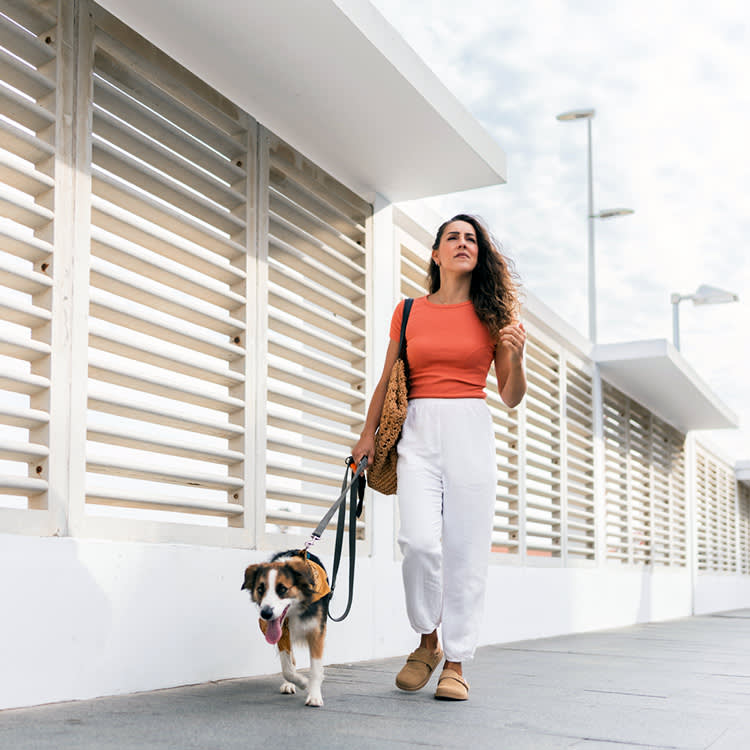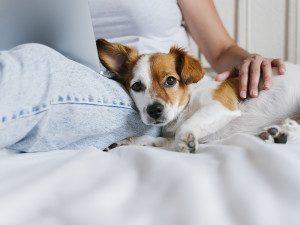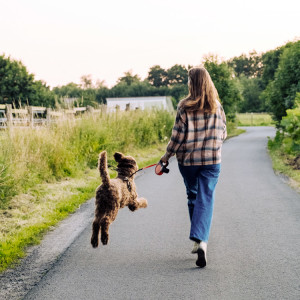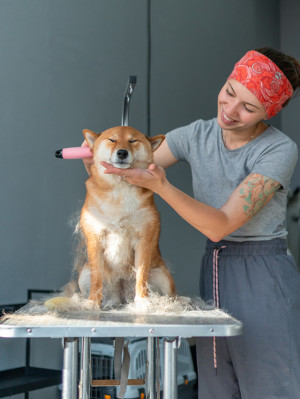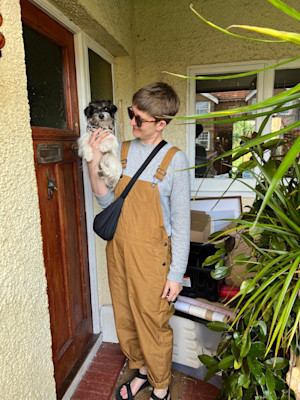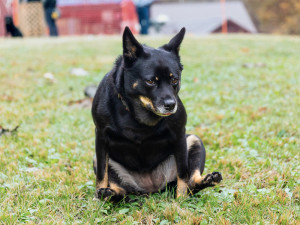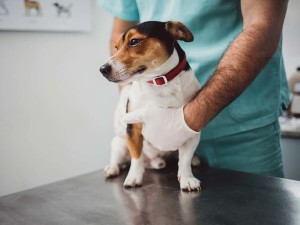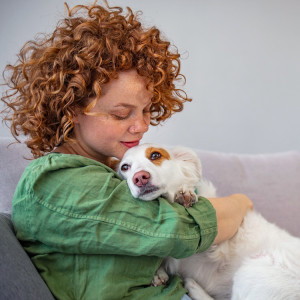How to Care For a Dog in Season
If your female dog is not spayed, it’s crucial that you understand their fertility cycle
In this article:
What is a season? What is the heat cycle? Stages of a dog’s season Signs my dog is in season Care for a dog in season Misconceptions about dogs in heat Signs of a problem Benefits of spaying your dog
If you have a non-spayed female dog, the prospect of her going into season can be pretty daunting. We’ve all heard stories of accidental litters, stained carpets and conflicting advice on how to exercise a dog in heat. So, to get to the bottom of everything, we spoke to Dr Aimee Warner, Veterinary Surgeon at Waggelopens in new tab, for expert guidance on what exactly it means when your female dog is in season, the signs to look out for, how a dog’s reproductive cycle works, when exactly you should get your dog spayed, and how to prevent unwanted pregnancies. Here’s everything you need to know.
What does it mean when your female dog is in season?
When a female dog is ‘in season’ it means she’s fertile, or just about to be. “Most dogs will come into season every 6–7 months,” Dr Warner tells us, “but some, especially larger breeds, may have them less frequently.” It is typical for female dogs to experience roughly three seasons in two years.
Most UK pet parentsopens in new tab choose to spay their female dogs – an operation called an ovariohysterectomy which removes the ovaries and the uterus meaning their dog will no longer have seasons or be able to get pregnant. Some practices do now offer a new keyhole surgery called an ovariectomy just to remove the ovaries. For male dogs, this operation is called castration and involves removing the dog’s testicles so he can no longer produce sperm. Dogs who have been spayed do not experience a fertility cycle.
What is the heat cycle?
Lots of people use the terms ‘in heat’ and ‘in season’ interchangeably. Technically though, the term ‘in heat’ refers to a specific stage of a dog’s season called the oestrus cycle – the fertile part. When a female dog reaches sexual maturity she’ll begin to experience an oestrus cycle roughly twice a year.
As female dogs do not have a menstruation cycle like humans where we shed the lining of the uterus, they do not experience menopause. This means dogs will continue to have seasons throughout their life with reducing fertility (although complete halting of reproduction has been documentedopens in new tab).
Theoretically, this means a female dog could have puppies later in life – something that should be avoided as there is risk of an unhealthy pregnancy at an older age. The main risk of repeated cycles for dogs however, is getting pyometra – an infected uterus – as each cycle opens the cervix, allowing bacteria to enter. Pyometritis is a life-threatening condition that may require expensive and invasive surgery. The best way to prevent pyometra is to spay your dog while they are young and healthy.
“Exactly when a bitch will come into season varies depending on breed and size,” explains Dr Warner. “Most smaller dogs will have their first season at around six months old, whilst larger breeds may not come into season until they are more than a year old.”
The first couple of seasons can be irregular and sometimes the first season is split. This means the pup can appear to be in season for 5–7 days, then again a few weeks later for the expected amount of time.
What are the stages of a dog‘s season?
As a whole, a dog’s fertility cycle is known as the oestrous cycle, and it’s made up of four stages:
Proestrus
Lasting from 3–17 days, this stage is when your dog’s body is preparing for the possibility of pregnancy. Her oestrogen levels will increase which causes an oedema (swelling) of the vulva (which can become much larger than normal) and the uterus as blood vessels dilate.
Some of this blood might seep through, which is the source of any blood spotting you may notice. This is very different to the lining of the uterus shedding like during the human reproductive cycle (no pain or period cramps involved!). This is the stage where you’ll begin to notice increased attention from male dogs and some behavioural changes. Male dogs can often smell when a bitch is in the proestrus or oestrus stage from a surprising distance – especially if they haven’t been castrated.
Oestrus
Confusingly similar in name to the cycle as a whole, the oestrus stage is 3–21 days long and it’s in this stage that your dog will ovulate. Multiple eggs are released – and your dog may be able to conceive multiple puppies. The discharge from her vulva will turn paler and more watery as her levels of the pregnancy-supporting hormone progesterone rise and her oestrogen falls. She’ll also be releasing the pheromones and hormones that signal her fertility to male dogs (she may be urinating more frequently in small bursts to help spread that message by marking). You’ll need to keep a close eye on her during walks to avoid unwanted attention and unplanned pregnancy. Mating can result in conception up to five days either side of ovulation as canine sperm is viable for approximately seven days.
Dioestrus
Lasting 2–3 months, this is the cooldown time after your dog’s fertile period (which lasts up to five days after ovulation during the oestrus stage). During dioestrus, her progesterone levels rise and peak before steadily falling until the next stage. You’ll notice her vulva return to its normal size, and she’ll no longer be interested in mating with male dogs. They should be less interested in her, too. However, it’s not always obvious when your dog has entered this stage of her cycle, so it’s best to continue to keep a close eye on her until four weeks have passed since her discharge began.
Anoestrus
The dormant stage in a dog’s reproductive cycle, this lasts on average 4–5 months. Your dog’s hormones will have returned to normal levels during this time and she cannot get pregnant. Inside, your dog’s uterus is slowly preparing for her next heat cycle. This is the recommended time to get her spayed – ideally three months after her season.
What are the signs your dog is in season?
It’s important to recognise the signs that your dog is entering her heat cycle and will be fertile soon. Caused by hormonal changes which prepare a dog’s body for mating and pregnancy, your dog may experience some discomfort, but she shouldn’t be in pain. The signs include:
Swollen or enlarged vulva. This often happens a few days before bleeding starts.
Vaginal discharge which is initially bloody then becomes watery. When less bloody it can be harder to notice. Discharge usually lasts 7–10 days in total.
Cleaning and licking their vulva more often.
More frequent urination.
Your dog’s hormones can also have a powerful effect on how she acts (and whether she listens to you). “Their behaviour can also change before and throughout their season. For example, they may be less willing to listen to commands or seem distracted,” says Dr Warner. “Other signs can include a reduced appetite or territory marking.” They may seem agitated or start whining more for no apparent reason. This can cause pup parents some worry, but it is natural.
“They ovulate and are fertile usually after the bloody discharge stops, this is when they are receptive to male dogs,” says Dr Warner. “Typically, this will be around 10–14 days after the discharge started.”
How to care for a dog in season
When she’s in season, there’s a lot going on inside your dog’s body. She may seem anxious, uncomfortable and even confused, so it’s important to show her extra TLC while she’s in season.
Keep a close eye on her during walks
On top of the risk of pregnancy from uncastrated male dogs, attention from other dogs can be stressful, so it’s a good idea to avoid busy parks while your dog is in season. Male dogs may be pushy about getting close to her, wanting to sniff her vulva or try to mount her if they get a chance. When mating, dogs get ‘locked’ together, tail to tail, facing away from each other. If your dog gets mounted by another dog this position can be a shock to humans as it is not widely recognised. Both dogs can also become quite stressed by it, so if it does happen, keep both dogs calm until they release each other naturally.
To avoid the likelihood of unwanted mating, opt for quieter routes or times of day, with her lead on so she can get some exercise without having to deal with potential suitors. If a male dog does appear to be making an advance, let the owner know that your dog is in season as soon as possible. Calmly separate them and lead your dog a safe distance.
Play with her more at home
As she’ll need to be on her lead or walked at quieter times, as walkies are likely to be less stimulating during her season. Up the fun while you’re at home with games like tug and enrichment activities like a snuffle mat, which will keep your dog mentally stimulated.
Be mindful of mess
While your dog is in season, bloody discharge is normal for up to 10 days. How heavily a dog in heat bleeds varies, with larger dogs tending to bleed more heavily. Discharge from your dog’s vulva can stain carpets, furniture and fabrics so some pet parents limit access to sofas and carpeted rooms, lay down old towels or puppy pads in their dog’s favourite spots.
Specially designed nappies, washable pants and sanitary pads are available, though it can take some trial and error to find the right fit for both your dog’s comfort and your sofa cushions. If you’re concerned about the amount your dog is bleeding, if any clots are seen, or if the blood has a foul smell, consult your vet.
Avoiding pregnancy
It is almost impossible to differentiate exactly between the different stages of a dog’s cycle. Even vets can only just about tell from vaginal swabs and cells looked at under a microscope, so it’s best to err on the side of safety. Keep her supervised while out and about and away from uneutered male dogs for four weeks to be sure to avoid her getting pregnant.
What are some common misconceptions about dogs in heat?
There are a number of myths about dogs in heat, and it’s important to know the facts in order to take care of your dog effectively. Here are some common misconceptions about dogs in season:
You shouldn’t exercise a dog in heat
As long as you supervise your dog and avoid potentially stressful interactions with male dogs, your dog still needs plenty of exercise during her season.
‘In season’ means she’s got her period
It does not. Dogs don't menstruate, they have the oestrous cycle instead. The ‘heat’ is during the fertility window. During the proestrus stage oestrogen levels will increase which causes the oedema of the vulva (which can become much larger than normal) and the uterus to become engorged as blood vessels dilate. Some of this blood might seep through which is the source of any blood spotting.
All dogs in season will spot blood
Nope. Dogs can have a ‘silent heat’ where no signs show but they are still cycling and can become pregnant. Most owners will think they skipped a season.
A dog should have one heat cycle before being spayed
Not necessarily. There’s now evidenceopens in new tab that having your dog spayed before her first season can reduce the risk of mammary cancer later in life. While the British Veterinary Associationopens in new tab say there’s not enough evidence to recommend a specific ideal age to spay a female dog, most vets recommend having your dog spayed between the ages of six months and two years for the best chance of avoiding health conditions later in life.
For further reading, it might be worth taking a look at this brilliant recent studyopens in new tab that takes into account the top 35 breeds and weighs up the likelihood of increased risk of cancer, incontinence issues, joint problems and risk of pyometra relating to when you get your dog neutered.
A dog is out of heat when she stops bleeding
False! It’s important to understand that your dog is fertile once her discharge turns paler, more watery and becomes less noticeable.
What are some signs something is wrong?
If you notice any of the following signs in your dog, contact your vet:
Prolonged discharge lasting longer than 10–14 days or a foul-smelling, discoloured vaginal discharge. This is a sign of a pyometra and usually occurs 4–8 weeks after a season. It‘s a very serious condition which can be fatal if left untreated.
Vulval swelling lasting longer than 3–4 weeks.
Signs of a false pregnancy such as nesting, mammary enlargement, milk production. A false pregnancy usually occurs after the season but not during. While false or phantom pregnancies are common in dogs and usually not dangerous, they can lead to mastitis (infection of the mammary glands) and a swollen tummy, which require treatment.
Any signs of being unwell such as vomiting, lack of appetite and lethargy.
What are the benefits of spaying your dog?
There are many benefits to spaying your dog, and if you’re not planning on having puppies, it’s definitely recommended.
“One of the main benefits is the reduced risk of mammary cancer,” says Dr Warner. “This is especially so if they are spayed when they are still young.”
“Other benefits include eliminating the risk of ovarian cancer and protecting your dog against a type of infection called pyometra (infection of the womb), which can be life-threatening. Most notably, it can prevent unwanted litters and saves you from the inconvenience of caring for a dog in season.”
